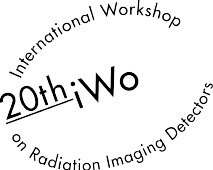Speaker
Description
Abstract: The Detector Group of the Swiss Light Source (SLS) at the Paul-Scherrer-Institute (PSI) has a long history of developing detectors for the needs of synchrotron sources. The advent of XFELs (like SwissFEL, which is constructed at PSI) has triggered the development of low noise, charge-integrating detectors with a high dynamic range of up to 104 . 12.4 keV photons per pixel. This high dynamic range per pixel has to be achieved without sacrificing single photon resolution in case of few incoming photons. Additionally the noise performance has to be better than the Poissonian fluctuations of the source at each point of the dynamic range to ensure the same data quality as single photon counting detectors. The SLS Detector Group has developed a novel method called dynamic gain switching, which is adapting the gain of each pixel to the incoming photon flux by dynamically adding additional capacitors into the feedback loop of the charge sensitive preamplifier.
JUNGFRAU is a charge-integrating pixel detector with a pixel pitch of 75 x 75 µm2, employing the aforementioned dynamic gain switching method to extend the dynamic range. Various high-Z sensors have been (GaAs and CdTe) has been investigated in order to extend the usable range of photon energies of our detectors. As JUNGFRAU has been developed for silicon sensors, dynamic gain switching is only working in hole collection mode. Therefore in case of using high-Z sensors which are preferable operated in electron collection mode, the gain stage (high, medium or low) has to be chosen in advance (fixed mode). When operated in fixed high gain mode the noise performance is 82 e- ENC and the available dynamic range is 71 keV.
Charge-integrating detectors offer interesting insights into the sensor properties as each pixel provides a direct measure of the collected charge of a well-defined area as output. On the other hand, each pixel is very sensitive to temporal as well as spatial sensor effects, which are affecting the charge collection (e.g. fluorescence, dislocation lines, detrapping of charge carriers etc.)
Over the last year several beamtimes have been performed at the Swiss Light Source (SLS) and the ESRF to test the usability of high-Z sensor materials (GaAs and CdTe) in combination with the JUNGFRAU readout chip. This presentation will focus on the results obtained with the GaAs-JUNGFRAU system. Amongst others the effect of the short hole lifetime of the GaAs sensors will be discussed and quantified.
